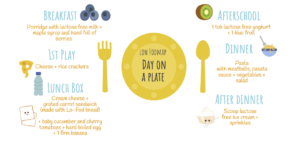
Kids with IBS
Irritable bowel syndrome (IBS) effects approximately 20% of school aged children. That’s one in five kids who regularly experience symptoms of abdominal pain, bloating, excessive wind or changing bowel motions. IBS is not a disease, however it is the most common cause of functional abdominal pain in children. Meaning they have these symptoms without any identifiable medical cause.
IBS Symptoms can negatively impact a child’s quality of life. For example, some children may spend prolonged periods on the toilet, avoid going to school or participate in sporting or social events. New research is beginning to show promising signs that a low FODMAP diet may improve the quality of life for children with IBS. If you are exploring dietary changes for your child, it is important to consult your child’s GP prior to trialling a low FODMAP diet to rule out any medical reasons for their symptoms.
What do FODMAPs do to the gut?
IBS symptoms can be triggered by many factors, the most common being stress and the foods we eat. FODMAPs can be found in a range of foods including grains, fruit, vegetables, legumes and dairy products. FODMAPs are types of sugars or carbohydrates that for one reason or another are poorly absorbed by some people. Instead, they travel to the large intestine where they are broken down and fermented by the healthy bacteria found there. This process produces gas in the gut, stretching the intestinal walls and causing pain and bloating. Additionally, excess water can also be drawn into the small intestines creating looser stools.
The kid friendly (simplified) low FODMAP Process
A standard low FODMAP diet can be highly restrictive, challenging to follow and is not always required for children. Instead, your dietitian may recommend a ‘simplified low FODMAP diet’. Using this approach, a dietitian specialising in FODMAP’s can target dietary changes to ensure that:
- Foods and food groups are not removed unnecessarily
- Results are achieved
- Your child’s nutritional needs for growth and development are met
- A healthy and positive relationship with food is maintained
A simplified approach is not only more relaxed it can also be a lot easier for families to follow. You can read more about a Simplified low FODMAP diet from Monash University here.
Like the standard low FODMAP diet, the simplified low FODMAP diet follows three key steps:
Phase One (elimination phase) this phase takes two to six weeks to complete. During this time, frequently eaten, very high FODMAP foods are swapped for low FODMAP alternatives e.g. swapping an apple (high FODMAP) for strawberries (low FODMAP). If symptoms improve during the elimination phase the challenge phase can begin.
Phase two (challenge phase) the second phase of the low FODMAP diet usually takes six to eight weeks to complete and involves testing for tolerance by systematically reintroducing individual FODMAP groups back into the diet – one at a time. High FODMAP foods that were previously removed can now be reintroduced in staggered amounts to test for tolerance. Your dietitian will provide more guidance on quantity, types of foods and how best to reintroduce them.
Phase three (personalisation) this is the fun part where you and your child get to create a personalised diet which includes adding back all the well tolerated foods and including smaller serves of less well tolerated foods. Any foods that were not tolerated can continue to be substituted from low FODMAP alternatives. For example, muffins made with regular wheat flour (high in FODMAP’s) can be substituted with muffins made with Lo-Fo Pantry’s Low FODMAP Plain Flour.
A child’s low FODMAP day on a plate

It is important to note that FODMAP’s are not dangerous and do not harm the body. They are in fact often in very healthy foods. Ultimately, the goal of the process is to improve your child’s quality of life by managing symptoms and incorporating lots of variety in the long term. The low FODMAP diet does not need to be a game of perfection. Breaking the diet occasionally for a birthday party won’t upset progress and can in fact, be beneficial for your child’s quality of life.
Final thoughts
Cooking with kids can be messy, but it is a delightful way to have fun and get your kids get involved with food. Besides, who doesn’t love a bit of mess occasionally! Why not get creative and enjoy baking some of these low FODMAP recipes with your children today:
When it comes to kids and FODMAP’s, always start by seeing your local GP then getting in touch with a dietitian who specialises in the low FODMAP diet and IBS. A qualified dietitian will ensure a normal life is maintained, by tailoring dietary advice for your child and family. Happy baking!








